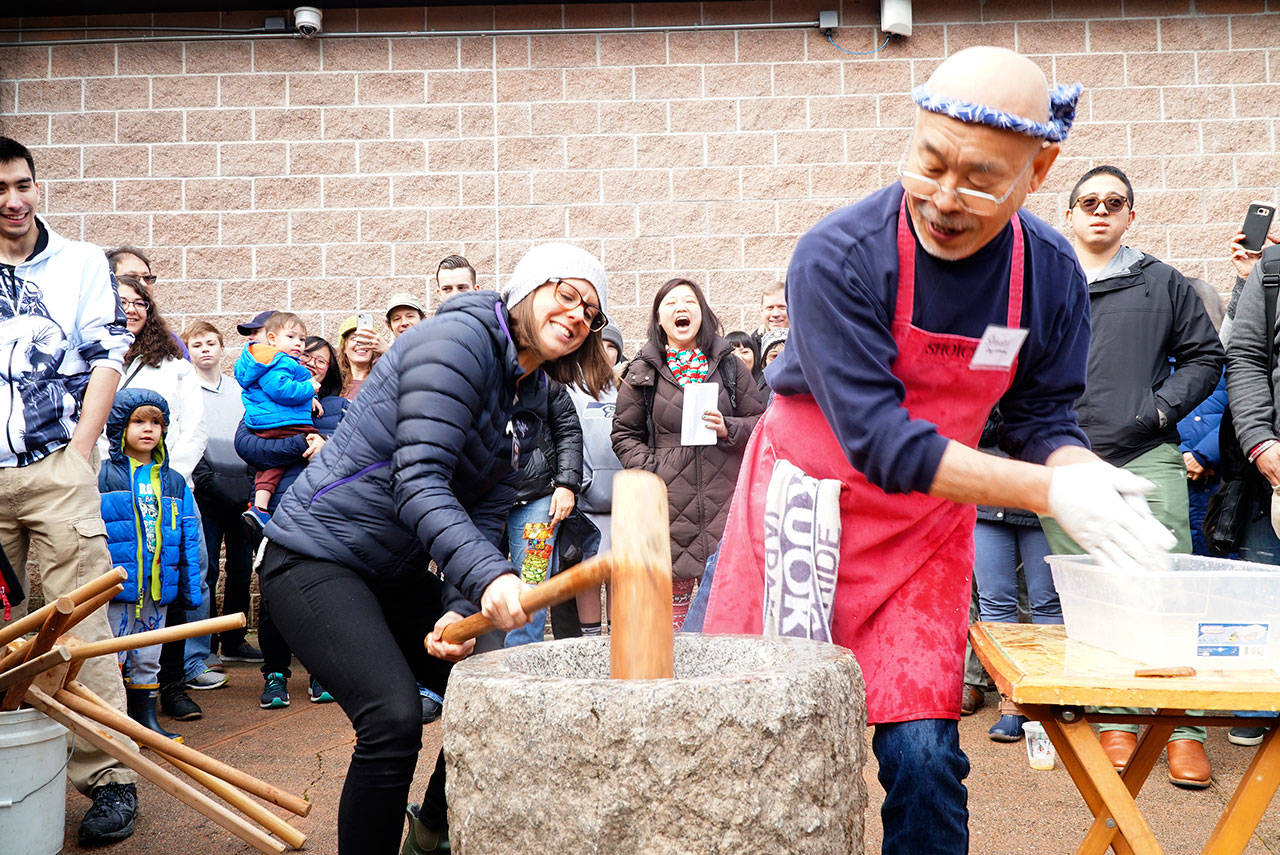In a way, finally, after three decades, the now-iconic Bainbridge mochi tsuki event has come home.
The beloved island tradition, reportedly the largest of its kind in the country, marked its 30th year Saturday, Jan. 5 with all the fun and tradition guests have come to expect, but in a new location that proved perfect both logistically and philosophically.
Woodward Middle School, set to be the stage for what is arguably the island’s most famous gathering (besides perhaps the Grand Old 4th of July) for the next two years at least, was named after renowned Bainbridge Island Review editors Walt and Milly Woodward, famously the only publishers on the West Coast to openly stand against the forced relocation and internment of Japanese Americans in the wake of the attack on Pearl Harbor.
The annual mochi tsuki event, indelibly twined as it is with the story of the internment and the unique response of most islanders — protecting their neighbor’s possessions and property, calling for their release, and ultimately eagerly welcoming them home again — could not have found a more appropriate venue, said Clarence Moriwaki, president of the Bainbridge Island Japanese American Community, longtime hosts and facilitators of the event.
“[It was] the only newspaper at the beginning to support Japanese Americans, throughout the war editorialize against the president’s unconstitutional actions and the only paper to have people write back every week to chronicle the histories,” Moriwaki said.
“That spirit of community, and how friends and neighbors looked after their properties, was so unusual around the country. That we’re here at Woodward is a perfect circle, I think, for the Japanese American story on Bainbridge.”
The ever-increasing popularity of the event — its having outgrown all previous venues, including, most recently, IslandWood — and the simultaneous increased discussions around and acknowledgement of the incarceration of so many Japanese Americans, in light of current turbulent political goings-on, Moriwaki said, is encouraging.
“People know this story and they connect it to the exclusion, they connect it to family’s being separated … so people know the relevance,” he said. “And the motto, Nodoto Nai Yoni, Let it Not Happen Again, is both aspirational and it’s also a call to action and that’s what we hope to inspire.”
According to BIJAC, the mochi gathering began as a small informal New Year’s celebration at the former Bainbridge Cleaners, in Winslow. It quickly grew in popularity, however, and moved to Island Center Hall. After a few years, it grew even bigger and moved again to the Filipino American Community Hall.
In 2004, IslandWood hosted their first mochi tsuki celebration, where the event was held every year since — until now.
“We just kind of outgrew it,” Moriwaki said of the event’s most recent host venue. The most attended year at IslandWood reportedly saw 2,300 people turn out — it was getting to be a fire hazard.
Still, change will of course always have detractors, though Moriwaki himself sees the increasing popularity (he estimated about 3,000 people attended this year) as a wholly good thing.
“Actually, someone just today said, ‘I really liked it when it was at Island Center 28 years ago,’” he said. “Well, yeah, but what did you like? ‘Oh, it was a small community event.’
“I feel proud and happy about [the growth] because the community has embraced it, and it’s the community’s event now, it’s not just a Japanese American community event. It’s something that’s now truly a tradition.”
And it is, in fact, a tradition built on an even older one.
For more than 1,000 years, making and eating the sweet rice treat mochi has been a celebrated New Year’s tradition in Japan, with generations of families and communities coming together to wish good health and prosperity for the new year.
Traditional mochi pounding, hand-forming mochi, origami folding and a new BIJAC history game with prizes was featured at this year’s event, along with displays of the award-winning “Kodomo No Tameni – For the Sake of the Children” exhibit recalling 100 years of Japanese American history on Bainbridge Island, and also plans for future phases of the Bainbridge Island Japanese American Exclusion Memorial.
The move to Woodward was made possible, Moriwaki said, thanks to a cultural grant from the city of Bainbridge Island and support from event partners Town & Country Market, Bainbridge Island’s ACE Hardware and IslandWood.
BIJAC members once again prepared batches of mochi in the centuries-old method Saturday, first steaming the sweet rice over an open fire and then placing the cooked rice into a warm stone or concrete bowl called an usu. Using large wooden mallets, several people (typically supervised volunteers) then rhythmically pound the rice in the usu, while, with bare hands, another person (most famously regular BIJAC volunteer and unofficial face of the event Shoichi Sugiyama) swiftly moves the rice between each mallet crash.
After several minutes of vigorous pounding, the rice becomes a thick, smooth dough, called mochi. From there the mochi is removed and guests hand-form the steaming-hot mochi into small handball-sized cakes, filling some of them with a sweet bean paste called ahn. BIJAC officials said that while arguably mochi is arguably best eaten hot and fresh, many do enjoy roasting it in the oven later and then dipping the puffy and crisp hot mochi cakes into a combination of sugar and soy sauce.



